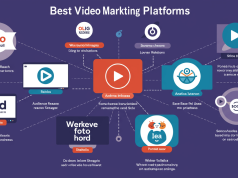Video has become the dominant force in digital marketing, transforming how businesses connect with their audiences. With over 3.7 billion internet users consuming video content daily, marketers who ignore this medium risk falling behind competitors who’ve embraced its power.
Whether you’re a marketing professional looking to expand your skill set or a business owner seeking new ways to reach customers, this guide provides actionable insights to elevate your marketing efforts.
What is Video Content Marketing?
Video content marketing involves creating and sharing videos to promote your brand, products, or services. Unlike traditional advertising, this approach focuses on providing value to viewers through entertainment, education, or inspiration while subtly promoting your business.
Successful video marketing campaigns tell stories that resonate with target audiences. They build trust, demonstrate expertise, and create emotional connections that drive purchasing decisions. The format allows businesses to showcase products in action, explain complex concepts clearly, and humanize their brand through authentic storytelling.
Modern video marketing spans multiple platforms and formats, from short-form social media clips to comprehensive educational series. The key lies in matching your content style with audience preferences and platform requirements.
Why Video Marketing Matters More Than Ever
Consumer behavior has shifted dramatically toward video consumption. Statistics reveal that people retain 95% of a message when watching it in video format, compared to just 10% when reading text. This enhanced retention translates directly into marketing effectiveness.
Search engines prioritize video content, with pages containing videos being 53 times more likely to appear on the first page of search results. Social media algorithms also favor video posts, typically delivering 48% more views than image-based content.
The versatility of video content provides additional advantages. A single video can be repurposed across multiple channels, transformed into blog content, broken into social media snippets, and used in email campaigns. This multi-use capability maximizes your content creation investment.
Videos also generate higher engagement rates across all platforms. They encourage social sharing, spark conversations, and drive website traffic more effectively than static content formats.
Types of Video Content That Drive Results

Educational Videos
Educational content positions your brand as an industry authority while providing genuine value to viewers. Tutorial videos, how-to guides, and explanatory content perform exceptionally well because they solve specific problems your audience faces.
These videos work particularly well for complex products or services that require demonstration. Software companies, for example, use screen recordings to show features in action, while manufacturing businesses create process explanation videos.
Behind-the-Scenes Content
Authentic, behind-the-scenes videos humanize your brand and build emotional connections with audiences. They offer glimpses into company culture, production processes, or team personalities that customers rarely see.
This content type works especially well on social media platforms where authenticity drives engagement. Restaurant chains showcasing food preparation, creative agencies documenting project development, and retail brands highlighting employee stories all benefit from this approach.
Customer Testimonials and Case Studies
Video testimonials carry more weight than written reviews because viewers can assess body language, tone of voice, and genuine emotion. They provide social proof that influences purchasing decisions more effectively than any sales pitch.
Case study videos that walk through customer success stories demonstrate real-world value while addressing common objections. They work particularly well for B2B companies with longer sales cycles.
Product Demonstrations
Product demo videos reduce purchase hesitation by showing exactly how items work and what benefits they provide. They’re particularly valuable for e-commerce businesses, where customers can’t physically examine products before buying.
Effective demos focus on key features and benefits rather than every technical specification. They address common questions and concerns while highlighting unique selling points that differentiate your products from competitors.
Creating Compelling Video Content
Planning Your Video Strategy
Successful video marketing begins with clear objectives. Define what you want each video to accomplish, whether that’s increasing brand awareness, generating leads, driving sales, or educating customers. Specific goals guide content creation decisions and provide measurable success metrics.
Identify your target audience’s preferences, pain points, and viewing habits. Research which platforms they use most frequently and what types of content generate engagement. This information shapes your content calendar and platform selection.
Budget considerations affect everything from production quality to posting frequency. Determine what resources you can allocate to video creation, including equipment, software, talent, and time investment.
Scriptwriting and Storytelling
Strong videos start with compelling scripts that grab attention immediately. The first few seconds determine whether viewers continue watching or scroll past your content. Lead with your most engaging element, whether that’s an intriguing question, surprising statistic, or visual hook.
Structure your narrative using proven storytelling frameworks. The problem-solution format works well for educational content, while the hero’s journey resonates with case studies and testimonials. Keep scripts conversational and focused on viewer benefits rather than company features.
Include clear calls-to-action that guide viewers toward desired behaviors. Make these instructions specific and time-sensitive when possible to encourage immediate action.
Production Essentials
High-quality video doesn’t require expensive equipment, but certain elements are non-negotiable. Clear audio tops the priority list because viewers will abandon videos with poor sound quality faster than those with mediocre visuals.
Lighting significantly impacts perceived production quality. Natural light works well for many scenarios, while basic LED panels can improve indoor recordings dramatically. Stable footage is equally important, with tripods or stabilizers preventing distracting camera shake.
Keep production timelines realistic and allow extra time for unexpected challenges. Technical difficulties, weather changes, or scheduling conflicts can derail tight production schedules.
Platform-Specific Video Marketing Strategies
YouTube Marketing
YouTube functions as both a social platform and search engine, requiring content that performs well in both contexts. Optimize video titles and descriptions with relevant keywords while maintaining readability and appeal.
Thumbnails significantly impact click-through rates on YouTube. Create custom thumbnails that accurately represent your content while standing out in crowded feeds. Use contrasting colors, clear text, and engaging imagery to capture attention.
Consistency builds YouTube audiences more effectively than sporadic posting. Establish a regular upload schedule and communicate it clearly to subscribers. This predictability encourages repeat viewing and improves algorithm performance.
Social Media Video Content
Each social platform has unique video requirements and audience expectations. Instagram favors visually stunning, brief content, while LinkedIn responds well to professional, educational material. TikTok prioritizes entertainment and trending formats, whereas Facebook performs well with longer-form content.
Optimize videos for mobile viewing since most social media consumption happens on smartphones. Use vertical or square formats when appropriate, ensure text remains readable on small screens, and consider silent viewing capabilities.
Timing affects social media video performance significantly. Research optimal posting times for each platform and your specific audience. A/B test different posting schedules to identify when your content generates maximum engagement.
Measuring Video Marketing Success
Key Performance Indicators
Track metrics that align with your video marketing objectives rather than vanity metrics that look impressive but don’t drive business results. View counts matter less than completion rates, engagement quality, and conversion metrics.
Engagement metrics like comments, shares, and likes indicate how well your content resonates with audiences. High engagement rates suggest your content provides value and encourages further interaction with your brand.
Conversion tracking reveals video marketing’s impact on business objectives. Set up goal tracking in analytics tools to monitor how video viewers progress through your sales funnel compared to other traffic sources.
Analytics Tools and Platforms
Most video hosting platforms provide built-in analytics that offer valuable insights into audience behavior. YouTube Analytics shows detailed demographic information, traffic sources, and engagement patterns. Social media platforms offer similar data through their business account features.
Google Analytics can track video performance across your website and measure how video content affects overall site metrics. Set up event tracking for video plays, completion rates, and subsequent user actions.
Third-party analytics tools provide more comprehensive cross-platform insights and advanced measurement capabilities. These tools help identify which content types and platforms deliver the best return on investment.
Video Marketing Trends and Future Opportunities
Live streaming continues growing as audiences seek authentic, real-time connections with brands. Live videos generate higher engagement rates and create urgency that encourages immediate participation.
Interactive video content, including shoppable videos and clickable elements, bridges the gap between entertainment and commerce. These formats reduce friction in the customer journey by enabling immediate action without leaving the video player.
Short-form video content dominates social media consumption, driven by platforms like TikTok and Instagram Reels. Brands that master brief, engaging storytelling gain significant competitive advantages.
Personalized video content, powered by artificial intelligence, enables scaled one-to-one communication. This technology allows businesses to create customized videos for different audience segments or individual customers.
Getting Started with Video Content Marketing
Begin with content formats that match your current resources and capabilities. Simple smartphone videos can be highly effective when planned and executed well. Focus on providing value rather than achieving perfect production quality initially.
Create a content calendar that ensures consistent posting while avoiding burnout. Start with manageable frequency goals and increase production as you develop efficient workflows and see positive results.
Repurpose existing content into video formats to maximize your investment. Blog posts can become explainer videos, customer testimonials can be recorded remotely, and presentations can be transformed into educational content.
Test different content types and platforms to identify what resonates with your audience. Use analytics data to refine your approach and double down on successful formats while discontinuing underperforming content.
Transform Your Marketing with Video Content
Video content marketing offers unparalleled opportunities to connect with audiences, demonstrate value, and drive business growth. The combination of visual storytelling, emotional engagement, and platform versatility makes video an essential component of modern marketing strategies.
Success requires strategic planning, consistent execution, and continuous optimization based on performance data. Start with clear objectives, focus on providing value to your audience, and gradually expand your video marketing efforts as you gain experience and see results.
The businesses that embrace video marketing now will have significant advantages over competitors who delay adoption. Consumer preferences have shifted decisively toward video content, making this the optimal time to develop your video marketing capabilities and capture market share.









